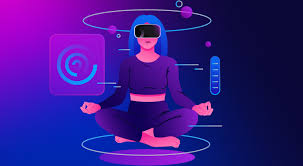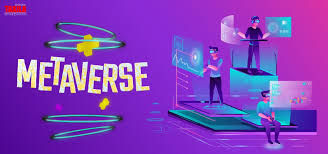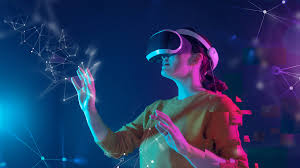What is the metaverse?
The metaverse has emerged as 3-D-enabled digital space that uses virtual reality, augmented reality, and other advanced internet and semiconductor technology to allow people to have lifelike personal and business experiences online.

Once people get the gist, most of them are all in: A research shows that approximately 60 percent of consumers are excited about the transition of everyday activities like shopping, dating, and working out to the metaverse.
But it’s not just individuals who are meta-curious: private capital is betting big money on the metaverse. In 2021, metaverse-related companies reportedly raised more than $10 billion, more than twice what they did in 2020. And so far in 2022, more than $120 billion has flowed into the metaverse. Research shows that the metaverse has the potential to generate up to $5 trillion in value by 2030. It’s an opportunity that is too big to ignore.
The metaverse means different things to different people. Some believe it’s a digital playground for friends. Others think it has the potential to be a commercial space for companies and customers.
It is believed both interpretations are correct. In June 2022, McKinsey released Value creation in the metaverse, a new report based on surveys of more than 3,400 consumers and executives, as well as interviews with 13 senior leaders and metaverse experts. Based on this analysis, it is believed that the metaverse is best characterized as an evolution of today’s internet—something we are deeply immersed in, rather than something we primarily look at. It represents a convergence of digital technology to combine and extend the reach and use of cryptocurrency, artificial intelligence (AI), augmented reality (AR) and virtual reality (VR), spatial computing, and more. And the “enterprise metaverse” may coalesce in a way that unlocks even more opportunity, beyond simply serving as a virtual place where people interact.
At its most basic, the metaverse will have three features:
—a sense of immersion
—real-time interactivity
—user agency
And ultimately, the full vision of the metaverse will include the following:
—platforms and devices that work seamlessly with each other
—the possibility for thousands of people to interact simultaneously
—use cases well beyond gaming
The metaverse isn’t about escaping reality, says futurist Cathy Hackl. Instead, it’s about “embracing and augmenting it with virtual content and experiences that can make things more fulfilling and make us feel more connected to our loved ones, more productive at work, and happier.” For Brian Solis, Salesforce’s global innovation evangelist, “what the metaverse is really all about is community. The value of belonging to this community. The role you can play as a user in this community so that you feel like a stakeholder and not a ‘user.’”
What’s more, the metaverse increasingly seems like an inevitability. “We’re going to see more brands, more investment, and more users in all things 3-D and real-time rendered,” says technologist and author Matthew Ball. “These are all trends that have been going on for multiple decades, and there’s no reason to believe that time spent online, the number of smartphones in use, and the criticality of digital to our economy are going to reverse.”
What are AR and VR?
Simply put, AR, or augmented reality, uses technology to add or augment a person’s view of reality with a computer-generated image. If you’ve tried Pokémon Go on your smartphone or the IKEA furniture placement app, you’ve experienced AR. The game lets players catch characters based on their real locations on a map. It’s physical and virtual all at once.
Advanced AR headsets—together with new and enabling technologies such as 5G, edge computing, and cloud capable of delivering mega volumes of data—are helping the metaverse deliver a level of virtual digital experience that is more realistic than the online gaming platforms that have been around since the early 2000s (and were the early forebears of the metaverse), where people could create avatars through which they could have semi-lifelike virtual experiences.
Virtual reality (VR), on the other hand, doesn’t include a physical-world component (besides the handset or other equipment such as a helmet or sensor-laden gloves). In VR, users enter a computer-generated simulation but can interact with it in a way that seems real. You might be familiar with videogames that use VR, but the technology is used in a variety of other ways that go beyond recreation.
Here are some examples of how AR and VR can be used:
—in immersive ideation for product development
—during design-to-value (DtV) exercises
—in the “creative economy” (art, journalism, music, etcetera) by offering opportunities to create transformative experiences by promoting new feelings, skills, and understanding
—in sports and entertainment (fans might watch 360-degree AR replays, for example)
—in retail for “experience design” (creating a “wow” factor in retail, beyond just shopping)
Mixed reality, or MR, is a term you might also see. That generally refers to situations that combine elements of both AR and VR. With mixed reality, you can use elements of the real world to interact with a virtual environment. To borrow an example from gaming, if you were playing a mixed-reality game with a headset, you could in theory pick up an item from your desk or coffee table and incorporate it into the game.
What does the metaverse consist of?
Metaverse consists of ten layers, which fall into four categories: content and experiences, platforms, infrastructure and hardware, and enablers. Here are some examples of each:
Content and experiences
—content—developed by users, creators, and developers—enriches metaverse experiences
—applications tied to specific metaverse use cases, such as learning or events
—virtual worlds where groups can gather, interact, and create
Platforms
—platforms that facilitate access and discovery of content, experiences, and apps
—platforms designed for creators of 3-D experiences
Infrastructure and hardware
—people interface with the metaverse via devices, operating systems (OS), and accessories
—the metaverse is powered with underlying infrastructure such as cloud computing, semiconductors, networks, and more
Enablers
—security, privacy, and governance are critical for the metaverse to function well and fairly
—tools and apps that manage digital identity
—tools to access the metaverse economy via payments and monetization
What technological advances will drive the development of the metaverse?
Just as blockchain has energized the decentralized creator economy, rapid technological advances promise to unlock future metaverse experiences and interoperability between worlds. The full rollout of 5G will enable users to process large worlds on mobile devices. Here are some other advances that will facilitate development of the metaverse:
—Back-end engines will knock down barriers to creation, enabling wider audiences to create advanced games and experiences. This will facilitate a shift from 2-D internet spaces to fully immersive experiences.
—Edge computing will drive the computing power required to run the metaverse. Edge computing enables data to be captured, stored, and processed locally rather than in the cloud, solving problems of limited bandwidth and latency.
—Hardware devices will merge the physical and virtual worlds. Meta shipped ten million Oculus Quest 2 headsets in 2021, and new devices including gloves and bodysuits are gaining traction as well.
—Software development drives metaverse applications on top of infrastructure.
It’s important to keep in mind that the technology to fully realize the potential of the metaverse doesn’t exist yet. Advancements will be required in compute infrastructure, network infrastructure, and interface hardware.
Metaverse and Mental Health
Digital use can bring escape and relief from the stresses of life and invoke temporary pleasure, but excessive digital use is associated with many mental health issues including depression, irritability, stress, paranoid ideation, somatic symptoms, and psychoses, among others.
For better understanding kindly refer to above article. It explains the benefits and restrictions of using Virtual Reality.
Is the metaverse just a fad?
It’s not uncommon to hear the metaverse described as a flash in the pan, soon to burn out. While we don’t know how this technology will evolve, we do track great interest and involvement from customers—which indicates a fundamental change to the way people use the technology of the internet.
The change is already upon us. According to a recent McKinsey survey, more than 20 percent of the population, on a net basis, say they will spend more time exercising, working, reading, and shopping online in the future. And 10 percent of the population has already tried AR or metaverse dating, and a majority enjoyed it more than the real-life alternative.
Here are six reasons the metaverse is here to stay:
- Constant technological improvements—for instance, in computing power and large-data processes such as graphics rendering—allow ever-larger virtual worlds to exist. As discussed, the rapid adoption of 5G is enabling people to access these worlds via their mobile devices more easily. Finally, production costs of AR and VR hardware are declining, and new devices such as haptic gloves and bodysuits are increasingly coming onto the market.
- Tech companies have made huge investments to build the metaverse. Companies big and small are increasingly keen to participate.
- Gaming in the metaverse is already mainstream but expanding use cases are making the metaverse more accessible. Immersive retail, sports, and educational experiences are becoming available, as well as corporate applications like employee trainings and team collaboration. In South Korea, the city of Seoul even announced the creation of a virtual Mayor’s Office.
- Online commerce is already mainstream. Commerce in the metaverse is much the same as the buying and selling people are already used to doing—except it’s with cryptocurrency. And as cryptocurrencies grow more common, the barrier to entry will become lower and lower.
- Gen Z consumers are coming into financial maturity. They are more familiar and comfortable with virtual worlds, transactions, and goods than millennials or previous generations tend to be.

- A shift toward influencer marketing bodes well for the metaverse. A significant share of innovative and engaging experiences will probably come from these creator-users.
A final note on the long-term potential of the metaverse: McKinsey estimates that the metaverse may generate up to $5 trillion by 2030 across consumer and enterprise use cases. With momentum building to the tune of trillions, we’re firmly exiting fad territory.
What does gaming have to do with the metaverse?
Many associate gaming with metaverse, for good reason. Gaming fuels the so-called “proto-metaverse,” the metaverse that exists today. With three billion users globally and a total value of more than $200 billion, the gaming sector eclipses the movie and music industries—combined.
But the fully realized metaverse won’t be just for gaming. “I see gaming as the on-ramp,” says Cathy Hackl. “When you talk about some of those enabling technologies or the infrastructure that’s needed, you can’t escape talking about game engines, like Unreal Engine or Unity.”
Indeed, “use cases beyond gaming are not just in the future,” says Kavya Pearlman, founder and CEO of XR Safety Initiative. “They’re already emerging.” The metaverse is expected to go beyond “gaming 2.0.” One example that illustrates the momentum: the amount of money spent on in-game, virtual goods. In 2015, spending on these was roughly $5 billion; in 2021, that figure reached $60 billion or $70 billion, even excluding nonfungible tokens (NFTs).
Why the uptick? Beyond technological advances (in broadband penetration, latency, and graphics processing units), broader cultural shifts are afoot, says technologist and author Matthew Ball. “This idea that we’ve thought of for decades is now a little bit more tangible, even if in the virtual sense,” Ball notes. “There are hundreds of millions of people connecting to these environments every day. There are many of the most storied companies on earth building a presence, and we have commerce in the tens and soon to be hundreds of billions of dollars.”
Consumers are already beginning to see the metaverse as something more than just a place to play. When McKinsey asked consumers what immersive digital activities might be of interest to them in the future, respondents listed social gaming in AR or VR ninth, behind things such as immersive shopping, learning, traveling, and socializing.
How will people experience the metaverse?
The pandemic (COVID) fuelled an increase in the acceptance of virtual interactions, and the metaverse is geared to connect physical and virtual worlds via commerce. The emerging metaverse in fashion and retail is where brands are already launching stores, games, and digital events.
The future metaverse will likely be much broader. “I believe absolutely that the advent of graphics-based computing and 3-D environments is going to change many of the technologies, standards, conventions, and monetization models,” says Ball. And that impact could be lasting. “It’s going to have profound generational change. Most importantly, it’s going to reach many of the categories we’ve long hoped would be altered by mobile and the internet and yet haven’t been.”
Some organizations are already making use of the metaverse in their businesses. Here are examples of real-world metaverse applications:
—For entertainment, you might attend a virtual concert or event: Lil Nas X performed in online gaming platform Roblox during the pandemic, for example.
—Commerce is shifting as we head into virtual spaces and shared experiences. According to McKinsey research, around 79 percent of consumers active on the metaverse have made a purchase, mainly to enhance their online experience. Virtual-to-virtual commerce—for instance, when a Fortnite player uses V-Bucks to make in-game purchases—is fairly common. Physical-to-virtual transactions are also being explored; toy company L.O.L Surprise! developed card packets with QR codes that can be scanned to unlock NFTs and virtual experiences.
—In healthcare, AR displays were recently used to perform surgeries on live patients at Johns Hopkins Hospital, helping its Neurosurgical Spine Center to execute tasks better than ever.
—Educational providers are creating coursework and materials that give teachers new ways to express and participate in classrooms; imagine that instead of building a papier-mâché model of a volcano you could virtually experience being the magma that’s ejected into the atmosphere.
—In heavy industries and other contexts, VR is being applied to help teach people new vocational skills, such as repairing trucks or other equipment—in some cases shortening training time considerably. And in field operations, people are using AR for remote assistance, which could be even more interesting as organizations begin to use the data generated from this process.
—In fashion and luxury, brands have made inroads. Take, for instance, Decentraland’s Metaverse Fashion Week in March 2022, which received significant industry attention and attracted brands such as Dolce & Gabbana, Estée Lauder, and Etro. The Gucci Garden, launched in 2021 in the Roblox gaming metaverse, saw 19 million visitors. Or consider new business models for virtual fashion, for instance, built around technology allowing for online showrooms or for 3-D virtual runways.
—NFTs, still in very early days, represent a new asset class in financial services, with some reports that loans have been collateralized based on NFT value, and other forays into the space beginning.
—Metaverse concepts could also help build more efficient and productive operations. Take the example of BMW, which has an all-electric vehicle production line that ran as a simulation for six months. Virtual cars were built on a one-to-one scale in the metaverse before the factory’s final layout was determined.
Are there metaverse risks?
Despite the promise of the metaverse, there remain risks. As Charlie Bell, Microsoft’s executive vice president of security, compliance, identity, and management, pointed out in a recent blog post: “The problems of yesterday’s and today’s internet—impersonation, attempts to steal credentials, social engineering, nation-state espionage, inevitable vulnerabilities—will be with us in the metaverse.”
LEGO Ventures’ Rob Lowe makes a similar comparison: “In the same way you wouldn’t have a child walking alone after midnight in the middle of Soho, you wouldn’t want the same thing to happen in the metaverse.”
Here are some other concerns to keep in mind:
—keeping data and privacy issues, along with regulatory standards related to user rights, top of mind
—ensuring the metaverses being built are equitable, safe, and sustainable, keeping talent and diversity issues in clear sight, while also minimizing biases related to technology
—addressing and stamping out abuse, harassment, and misinformation
How can business leaders prepare for the metaverse?
McKinsey research indicates that simply not participating in the metaverse may result in a significant competitive disadvantage. Here’s counsel from metaverse experts on what executives and other business leaders can do to prepare for the metaverse.
Square Enix CEO Yosuke Matsuda suggests:
—First, don’t box yourself into thinking that the metaverse is just one thing. “We’re trying to not define the metaverse so rigidly that it limits the imagination of creators,” says the CEO.
—Think local, act meta. The metaverse has great potential to address social issues. The Whole Earth Foundation’s Guardians of Metal and Concrete game, for example, crowdsources data on infrastructure conditions so repairs can be made in real time. “I’m quite interested in the aspect of blockchain as an incentive scheme,” Matsuda said, referring to the game. “It’s trying to solve social issues with games using the incentive scheme of blockchain. This is opening up whole new possibilities.”
LEGO Ventures managing director Rob Lowe advises:
—Don’t be afraid of idealism. With the metaverse, the ambition is “for the future to become as open as the internet was when it was first launched.” He said, “That is the kind of promise of what a future metaverse could be for everybody, not this idea of individual, siloed experiences.”
Futurist Cathy Hackl recommends:
—Get educated on the metaverse. And pass along that knowledge to your teams.
—Be strategic about how you respond to or approach the metaverse. If you’ve set up a marketing activation, for instance, you might need to take a step back to consider a holistic strategy.
—When it comes to talent, look internally. Consider who, within your organization, has the experience that’s needed now to think about the metaverse and start building teams. That might include innovation teams that have developed AR and VR for years, and that know how to think spatially and in 3-D. It could also involve rising leaders who are “crypto natives”: “Sometimes the smartest person might be the youngest person in the room,” says Hackl.
Matthew Ball’s thoughts include:
—For brands, the biggest challenge may be in moving from communicating a message or telling a brand story to creating an immersive environment that people choose to engage with on an ongoing basis.
—You can’t intellectualize your way through the metaverse. Exploring the space is necessary. Build an understanding of the metaverse and start testing within it.
Richard Ward suggests:
—One no-regrets move? Tap into people at your company who draw for a living: think graphic designers, marketers, product designers, and process engineers. They may already be using 3-D tools, which means you may already have the raw materials to start experimenting with metaverse capabilities that can be built out and presented to clients, workers, and other stakeholders.
—Start trying things out by experiencing the technology. “If you’ve got kids and they’ve got a VR game, especially a multiplayer game, go along for the ride and see what all the hoopla is about. Evaluate it from a systems perspective, asking questions like: What are the choices people make in the games? Why are people deciding to do this? How are they evaluating these problems and communicating about them?” The future of the metaverse, and a full understanding of its uses and benefits—as well as its risks—remains to be seen. While this new terrain is virtual, its potential is real.

